The Real
Samaritans
MT. GERIZIM, Palestinian
Territories, April 14, 2006
By CBS News read
article &watch the news clip live now
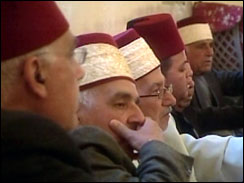 CBS news Poll polled 899 adults
randomly in the United States. 14% said they were familiar with the
religious Samaritans, 83 % were not familiar with 3% don't know or did not
answer. CBS news Poll polled 899 adults
randomly in the United States. 14% said they were familiar with the
religious Samaritans, 83 % were not familiar with 3% don't know or did not
answer.
A note from the Editor: The 14%
appears to be a little high, it must be either that these people think
they know the Samaritans totally from the Bible or just did not want to
admit that they did not know, which sounds American to me (smile). At any
rate the poll and article shown on the news was great!
```````````````````````````````````
The Samaritans - who broke away from Judaism 2,800 years ago - mark their
Passover in the West Bank.
http://newsimg.bbc.co.uk/1/hi/in_pictures/4903384.stm
```````````````````````````````````
Directions to
Orthodoxy
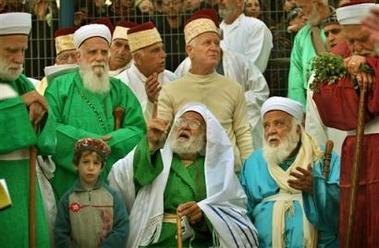
AP - Baz Ratner/ Samaritan Passover sacrifice in
photos
http://directionstoorthodoxy.org/mod/gallery/view-photo.php?photo_id=2591&sort=-1

http://photos1.blogger.com/blogger/7422/780/1600/IMG_0925.jpg
http://photos1.blogger.com/blogger/7422/780/1600/IMG_0924.jpg
http://www.mentalblog.com/2006/04/passover-from-nablus-to-nepal.html
Samaritan sect still clings to unique heritage, customs
http://www.ucc.org/ucnews/aug04/samaritan.htm
````````````````````````````````
Pilgrimage on the last day of Unleavened Bread
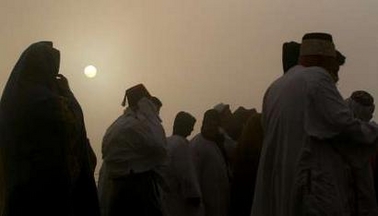
(Reuters) - Members of the Samaritan sect conduct a pilgrimage march to
mark Passover on Mount Gerizim on the outskirts of the West City of Nablus
April 18, 2006. The Samaritans, who trace their roots to the northern
Kingdom of Israel in what is now the northern West Bank, observe religious
practices similar to those of Judaism. REUTERS/ Yonathan Weitzman Yahoo
News see more photos at:
http://rss.news.yahoo.com/imgrss/events/lf/041006passover
````````````````````````````````
Photo News
 Nablus,
Israel, 11 April 2006 Israelite Samaritans perform their traditional
slaughter of the Passover sacrifice ceremony at Mount Gerizim, north of
the West Bank town of Nablus April 11, 2006. Samaritans, one of the tribes
from northern Israel, now number under 1.000 people in Israel. Inbal Rose/ReflexNews/Photonews
Portugal, Brazil, Romania rights
Related images.. 17 wonderful photos at
http://www.photonews.com.pt/?page=search just type in the search box
'Samaritans' Please contact them for use of their photos for your books
and any news article that may require a photo. Nablus,
Israel, 11 April 2006 Israelite Samaritans perform their traditional
slaughter of the Passover sacrifice ceremony at Mount Gerizim, north of
the West Bank town of Nablus April 11, 2006. Samaritans, one of the tribes
from northern Israel, now number under 1.000 people in Israel. Inbal Rose/ReflexNews/Photonews
Portugal, Brazil, Romania rights
Related images.. 17 wonderful photos at
http://www.photonews.com.pt/?page=search just type in the search box
'Samaritans' Please contact them for use of their photos for your books
and any news article that may require a photo.
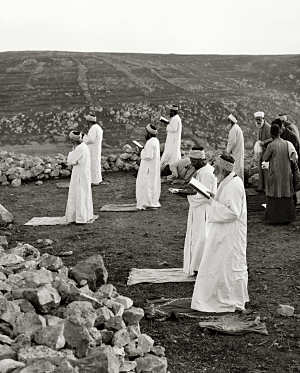
Samaritans Praying on Mount
Gerizim
Source: Matson Collection
http://www.lifeintheholyland.com
Live Animal Sacrifice
Live animal sacrifices used to be considered a good thing in the
Judeo-Christian tradition. Nowadays, most would find it barbaric and
archaic. However, there are still some places and peoples who perform this
ancient ritual today.
In 1996, I spent a few months traveling the Middle East, in Egypt,
Israel/Palestine, and Jordan. Every year around April 22, the Samaritan
Passover ceremony is held on Mount Gerizim. This is one day before/after
the Jewish Pesach (Passover) holiday. Mount Gerazim is up the hill from
Nablus, the largest Palestinian West Bank city. The top of Mt. Gerizim,
however, is like a "fourth world" country -- neither Israeli/Jew nor
Palastininan/Arab/Muslim. It's a special zone for the ancient Samaritan
sect.
Yes, the Samaritans are where we get the phrase "good samaritan" from.
There's only a few hundred Samaratins left. They have a small, urbanized
community called Holon near Tel Aviv, and their holy land "reservation"
atop Mt. Gerizim.
After a hellish day of hitchhiking and sketchy taxi rides across
checkpoints -- from Tiberias on the Sea of Galilee, through Nazareth,
dusty and tension-filled Jenin, and finally Nablus -- we hiked and hitched
our way to the top of Gerizim. The view was rewarding, overlooking Nablus
and a green valley ... Unfortunately, there was no water for sale, and we
were parched in the muggy, overcast afternoon. We met up with an American
grad student doing a thesis on the Samaritans, and he was able to
introduce us to a family who provided us with a jug of well water and a
seat to relax. We spoke about the pending ceremony and were told by one of
the elder Samaritans that "God always opens a hole in the sky to accept
the sacrifice."
Now I'm a reasonably cynical fellow. I don't believe miracles and
supernatural happenings are not possible, but when I hear someone telling
me they've seen one, well, I just can't help saying "uh huh, sure." We
thanked them for the water and went to sit in the spectator seats near the
sacrificial grounds.
There was dancing and singing and chanting and guys in some pretty cool
outfits. White with brightly colored trim, and nice but simple hats. After
an hour or so, there were 48 sheep herded into the sacrifice area. The
tension mounted as the goats were held steady for a long time while
everything was prepared and checked for perfection. Finally, with one
quick and quiet (blink and you'd miss it) group movement, the throats of
the sheep were sliced open with daggars. My companion tapped my shoulder
and pointed at the sky. Above us, the overcast dusk sky had a cloud break,
and a circle of dark blue sky appeared. Hmm.
After the live animal sacrifice, the participants relaxed and the audience
began to mill about, taking photos. Fires were lit in the giant pits, and
the barbecue began.
Unfortunately, the Samaritans don't share the BBQ meat with outsiders, so
unless I come back as a Samaritan in the next life, I won't get a chance
to try this unique feast.
Find out more about the Samaritans and Mount Gerizim.
After the ceremony we had to ask around for a ride to Jerusalem, and I'd
like to thank the group of American Mormons who let us take a seat on
their half-empty air conditioned tour bus -- even though they made us
pitch in for gas.
http://weirdmeat.com/feed/atom.xml
````````````````````````````````````
Jewish Calendar
- Hebrew Calendar
In addition,
the Samaritans and the Sadducees each had their own calendars. The
Samaritan calendar fixes the first day of the month by the conjunction of
the moon with the sun, not by the new moon, and their months are numbered,
not named. Although the Samaritan calendar adds an extra month for leap
years seven times in a 19-year cycle like the Jewish calendar, unlike the
Jewish calendar, months are not added or intercalated at set intervals.
Even the Jews of certain communities didn't always follow the calendrical
rulings of rabbis. For instance, the Syrian Jews of Antioch from 328 C.E.
to 342 C.E. always celebrated Pesach or Passover in March, regardless of
rabbinical calendrical rulings in Palestine.
https://www.angelfire.com/pa2/passover/jewish-calendar-hebrew.html
````````````````````````````````````````````
The
Shomronim. A Brief Glimpse on Har Greizim
by Jameel @ The Muqata
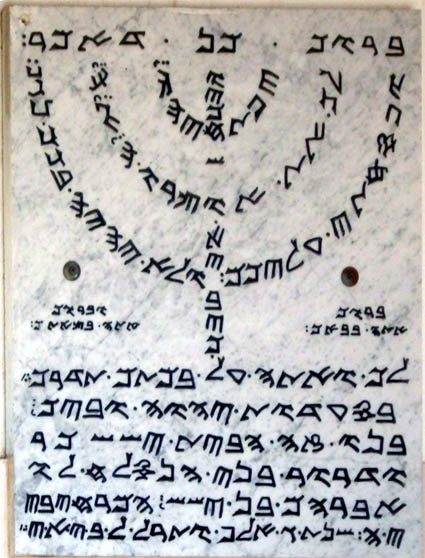 A
Shomronim "mezuza" -- a pasuk from the Torah hung on the wall inside the
house. Guess I shouldn't call it the "Torah" because its not really the
same as Judaism's. Well maybe the same, but they are
a different religion. A
Shomronim "mezuza" -- a pasuk from the Torah hung on the wall inside the
house. Guess I shouldn't call it the "Torah" because its not really the
same as Judaism's. Well maybe the same, but they are
a different religion.
Living on Har
Greizim, overlooking Shechem lives a small community of the Shomronim/Samaritans.
Since this topic came up on a different blog, I decided to write a quick
summary of my trip their last sukkot. They don't live that far from the
Muqata -- and it was easy getting there. Well, easy if you carry an M16,
and have rock-proof windows, but I don't consider that a big deal.
The Shomronim
are the descendants of the Kuttim, whe were brought to Eretz Yisrael from
Kutta, as part of an Assyrian policy of trans-migration, after the
destruction of the Kingdom of Israel (10 tribes), 150 years before the
first Beit Hamikdash was destroyed (Melachim II 17:24). The Shomronim
originally converted to Judaism because of fear of lions that attacked
them, but were eventually rejected by the Jewish people and deemed to be
non-Jewish (see Chulin 6a; Even Haezer) .
There are 2
communities of Shomronim living today in Israel; one community in Holon
(near Tel-Aviv), and one on Har Greizim, overlooking Shechem. Next door is
the Jewish town of Har Bracha, and there isn;t that much interaction
between the 2 communities. One's Jewish, one's Samaritan -- yet its eerie
that there can be so many familiarities between them, yet they are still
different religions. The Shomronim community in Holon wishes it could
integrate more with Israeli society, and say they are part of "Adat
Yisrael" -- but they aren't Jewish, and it just causes problems of
intermarriage (as if we don't have enough problems in Israel as is).
Continued--
http://muqata.blogspot.com/2005/09/shomronim-brief-glimpse-on-har-greizim.html
```````````````````````````````
Samaritans in Ramla and
surrounding area
Communities of
Samaritans lived in Ramla and its surroundings many generations prior to
the founding of the city. There are several archeological remnants left
from them. East of Ramla, In 1949, in SHAALVIM located in Ayalon valley,
ruins of a Samaritan synagogue were uncovered probably from the 5th or 6th
century.
In the floor is a mosaic with a verse from the Torah written in Samaritan
writing resembling biblical Hebrew. Also embeded in the mosaic is an image
of the MENORAH, remnants of greek writtings and a drawing of what seems to
be the GRIZIM mountain that is sacred to the Samaritans.
The Samaritans who apparently came from the near area, settled in Ramla
when the city was founded. Other communities of Samaritans are known to
have lived in the villages TZAFRIA and BEIT-DAGON at the time of the Arab
rule.
One Samaritan, a resident of TZAFRIA played an important role in the
governing of Ramla and due to his kindness with the people was named "The
Savior".
It was Heslig & Kims conquering in 1071 and later by the crusaders in 1099
that apparently terminated the Samaritan settlement in Ramla.
http://www.ramla.muni.il/E_ramla/history/shomronim.html
``````````````````````````````````````
The Jewish Community in the Gaza District:
With
Napoleon's invasion,
Gaza
was the first to fall. Napoleon had been known to be a friend to the Jews
and invaded
Palestine
in order to reestablish the Jewish state. But the Jews weren't convinced
of his actions, and reports from
Gaza
noted the terrible abuse the local Jews were suffering at the hands of the
French soldiers, at times joined by the local Arabs who had, long ago,
become more fanatical. They, therefore, fled in numbers, mostly to
Hebron.
Some Jews remained in
Gaza
for several more years afterwards, however, but owing to continued Arab
persecutions, even they fled, settling in
Jerusalem.
By the first decade of the 19th century, the old Jewish
community had vanished. Several years later, the Arabs expelled the small
Samaritan community. From that time until the late 1870s, no Jew or
Samaritan would dare live in the city. The area from the
River
of
Egypt
to
Jaffa
was given over to swamps, and Arab marauders and bandits.
http://english.katif.net/index.php?id=1435&sub=13
(Napoleon entered Gaza in 1798/9.)
````````````````````````````````````````````
The Scrolls of the Dead Sea - 6.1
Introduction
Another version of the Old Testament (or better of the
Pentateuch) is used by the small Samaritan community living at Nablus in
Jordan. The oldest manuscript of this text dates from the eleventh century
AD. It differs from the Massoretic text in 6000 places but most are
orthographic or syntactic variations with some supplements to correct
deficiencies, some repetitions, the removal of obscurities, and the
insertion of explanations. The substantial differences were introduced to
conform to the doctrine of the sect. However the Samaritan text is
definitely more readable and closer to the Septuagint. The text of the
fragments of the Pentateuch found in the fourth cave of Qumrān is closer
to the Samaritan version that to any others. This only means that the
Samaritan community's version of the Pentateuch is based on a text dating
from the fifth century BC when their community was founded, and that it
has not changed much since the second century. It would be wrong to throw
away the Massoretic text but, when the Samaritan text is clearer, it
should be taken into consideration too. It is really strange that such an
Orthodox Jewish sect, as that of Qumrān, has chosen, for their Bible, the
text produced 200 years before by the heretical Samaritan sect. All the
Qumrān biblical texts do not follow strictly one version only, even if the
Massoretic was predominant. They seem to have made a free choice of which
sacred scriptures to adopt, whereas their later brothers at Murabba'at,
sixty years later, followed closely the Massoretic tradition. In Qumrān
they did not hesitate to correct the text when its reading was difficult,
or to adapt it to the belief of the time.
http://www.nullens.org/content/view/112/47/
````````````````````````````````
Ancient Jewish Art in North Africa and Its Religious Significance
by
Baruch Kanael
http://ccat.sas.upenn.edu/psco/archives/psco12-min.htm
```````````````````````````````
Descriptive Geography and Brief Historical Sketch of Palestine.
The Passover Sacrifice קרבן פסח Among the
Samaritans, the Ancient Cutheans of 2 Kings 17.
By
Rabbi Joseph Schwarz, 1850
I have to
remark something which strikes me as peculiar among them. They call God
Ashima, and they use this term whenever the name of God is to be
pronounced in the Bible or their speech. But this word Ashima occurs in 2
Kings 17:30, as the idol of the men of Chamath (not of the Cutheans, who
worshipped Nergal), which first was, according to Talmud Sanhedrin, 63
b, in the shape of a goat. The modern Cutheans are, however, of a
mixed class, as they employ an image resembling a bird, much like a dove
(see Chulin, 6 a), which is carved of wood, and put on the top of
their rolls of the law which are written in the Syriac (Samaritan
character), and out of which they read a short passage every Sabbath
somewhat after the fashion of our modern reformers. The just-cited passage
of the Talmud avers that Nergal, the idol of the Cutheans, was a cock, a
bird, therefore, having nothing in common with the goat; and as
nevertheless the Samaritans use the word Ashima, which denoted the goat,
the idol of the Camatheans, it proves that they are of a mixed descent,
and not pure Cutheans merely.
http://www.shechem.org/machon/schwarz/palestine/cutheans.html
Editor's
comments: To bad this Rabbi did not take the time to talk to A
Samaritan-Israelite and learn that what he wrote here above was incorrect
information. Please see the following links for the real truth.
HOW THE
SAMARITAN ISRAELITES PRONOUNCE THE NAME OF GOD?
http://the-samaritans.com/html_articles/text3.html ,
Thoughts of A Karaite: Yohanan
Shalom Jacobson in
http://www.thesamaritanupdate.com/
February 12th,
2004
``````````````````````````
Used Square Hebrew Characters.
From the time of Ezra, however, the scribes occupied themselves
also with plans for raising Judaism to a higher intellectual plane. They
were, consequently, active in reviving the use of Hebrew, which had been
to a great extent forgotten during the exile in Babylon, and in giving it
a more graceful and suitable script. As to the latter, it is stated that
the Torah had first been written in Hebrew characters; then, in the time
of Ezra, in characters called "ketab ashshuri" (probably = "ketab suri" =
Syrian or Aramean script; comp. Kohut, "Aruch Completum," s.v. ),
the present square type, the former script being left to the "Hedyoṭot,"
that is, the Cutheans or Samaritans (Sanh. 21b-22a). It is evident that
the scribes, in making this change, wished to give the Torah a
particularly sacred character in distinction to the Samaritan Pentateuch.
The term "ketab ashshuri" is explained by one authority as meaning "the
even writing" (Yer. Meg. i. 71b), as contrasted with the forms of the
ancient Hebrew or Samaritan characters.
http://www.jewishencyclopedia.com/view.jsp?artid=407&letter=S&search=Tikkune
```````````````````````````````````````````
More links
Samaritan
All fonts found on žeſe web pages have been created by
žē aužor of žeſe pages, and are property of žē aužor. Licence agreements
may apply. Že Samaritan Font is free for personal uſe only. Commercial uſe
muſt first be approved by žē aužor.
Že Samaritan Font contains be characters of be
Samaritan alphabet, which doubled as be pre-Babylonian Hebrew alphabet as
well.
Current verſion was last updated: March 12, 2001.
Download Now (4Kb)
http://www.everywitchway.net/linguistics/fonts/samaritan.html
``````````````````````````````````````````
All is not fine
when traditions are altered
yossi
liebowitz, commentary
Published April 8, 2006
I am under no illusion that the Passover Seder as it has emerged over the
centuries bears a limited similarity to biblical celebrations. One need
only attend a Samaritan Passover to notice how the Jewish celebration has
grown and changed.
http://www.goupstate.com/apps/pbcs.dll/article?AID=/20060408/NEWS/604080303/1028/LIFE
Passover and the Ignored
Liberation
FrontPageMagazine.com | April 12, 2006 By Andrew G.
Boston
The Muslim historian Baladhuri (d. 892 C.E.), maintained that 30,000
Samaritans and 20,000 Jews lived in
Caesarea
alone just prior to the Arab Muslim conquest; afterward, all evidence of
them disappears. Archaeological data confirms the lasting devastation
wrought by these initial jihad conquests, particularly the
widespread destruction of synagogues and churches from the Byzantine era,
whose remnants are still being unearthed. The total number of towns was
reduced from fifty-eight to seventeen in the red sand hills and swamps of
the western coastal plain (i.e., the
Sharon).
http://www.frontpagemag.com/Articles/ReadArticle.asp?ID=21997
Videos
THE NEW ISRAELI FOUNDATION FOR CINEMA & T.V
White Robes, Blue Jeans
The Samaritans, The world's smallest and most ancient people, are caught
between
The State of Israel and the Palestinian Autority. They are a religious
community of less than 700 people, who continue to maintain their
traditions and rituals, dating back to biblical times, including the
Passover sacrifice. This film follows the lives of two young Samaritan
couples as they face the challenges of the modern world against the
backdrop of the Palestinian-Israeli conflict. Produced with the Support
of: National Geographic. Israel, 2002, Video, 52 Min. Hebrew (English
sub).
http://www.nfct.org.il/movies/White_Robes_Blue_Jeans_e.htm
Video Š The
Samaritans, the Promise Keepers
Produced for
the first time, this is a 30 minute film in English by the company Israel
Vision in Jerusalem and the AB Institute of Samaritan Studies that tells
the Samaritan story, focusing on the main festival of the year, the
Passover sacrifice. Shown in the background is the everyday Samaritan
life, customs and heritage. A beautiful gift for all ages. Price $40 US
plus $10 shipping.
http://www.mystae.com/reflections/messiah/publications/publications.html
From Jerusalem to Mecca, (The sons of Abraham), Cine & Tele
Productions, Belgium, 1987.
1 videocassette, 27 min.
One of 13 programs about the diverse religious and cultural groups
descendent from Abraham. The program looks at the significance of the Holy
City of Jerusalem, and at the groups which coexist within its walls. The
ancient Samaritan sect, the strict Hassidim, Greek Orthodox, Armenian and
Coptic Christians, and Muslims are shown participating in religious
ceremonies. Briefly describes the customs, symbols, and holy places sacred
to these groups.
A10807373 (Level: US)
http://education.qld.gov.au/information/service/libraries/resource/currtopics/religions-vi.html
Israel: Sounds in Search of a Home
What is Israeli music? What do the
music of ....the
Samaritans
51 min., #788,
Color, $29.95
www.Jewishvideo.com
Jesus in the Holy Land
In seven episodes the directors ingeniously portray the parallels between
the gospels of Jesus and the contemporary ways of life and religious
practice of Christians, Jews, Samaritans, and Moslems living in the Land
today. Video
http://www.thejerusalemgiftshop.com/jesus-holy-land-p-87.html
````````````````
Books
BAGSTERS
COMPREHENSIVE TEACHERS' BIBLE( RARE)LEATHER
ELEMENTARY INTRODUCTIONS TO THE
HEBREW AND GREEK 1896??
LONDON:: S.BAGSTER AND SONS,
LIMITED.NEW YORK JAMES POTT & CO., "/NO DATE".
ILLUSTRATION OF A PAGE FROM ONE
OF ARCHBISHOP USSHER'S MANUSCRIPTS OF THE SAMARITAN PENTATEUCH,
The
Archaeology of Israelite Samaria, Volume 1
Early Iron Age through the Ninth Century B.C.E.
Harvard Semitic Studies - HSS 44 by Ron E. Tappy
Harvard Semitic Museum,
1992
295 pages,
English
Cloth
ISBN: 1555407706
Your Price: $44.95
https://www.eisenbrauns.com/ECOM/_1RZ13ADMO.HTM
The
Archaeology of Israelite Samaria, Volume 2
Harvard Semitic Studies - HSS 50 by Ron E. Tappy
Harvard Semitic Museum,
2001
xxxi + 668 pages,
English
Cloth
ISBN: 1575069164
List Price: $89.95
Your Price: $83.65
https://www.eisenbrauns.com/ECOM/_1RZ136NDT.HTM
``````````````
A Day of Gladness: The Sabbath Among Jews and Christians in Antiquity
(Hardcover) by Herold Weiss "The origins of the
Sabbath are unavailable to us due to the lack of adequate sources..." 288
pages, University of South Carolina Press. ISBN 1570034680
Book
Description
In A Day of Gladness, Herold Weiss compares the ways in which Christians
and Jews of antiquity viewed the Sabbath. Rather than attending to the
minutiae of its observance among Jews or its connection with Sunday
observance among Christians, he examines major extant texts for the
fundamental religious concerns of their authors and communities,
particularly how those concerns shaped their thoughts about the Sabbath.
Weiss contends that the wide spectrums of theological beliefs illustrate
the internal diversities of these two faiths as well as their
commonalities.
To explore
Jewish perspectives, Weiss looks to the Rabbinic and Qumranic texts,
Samaritan texts, and the writings of Philo and of Josephus. To
illumine early Christian attitudes, he offers analyses of the Synoptic
Gospels, the Gospels of John and Thomas, and the letters to the
Galatians, the Romans, the Hebrews, and the Colossians. Weiss uses each
text as a window upon the sociological constructs and theological
perspectives figuring in early Jewish and Christian thought about
worship and rest. He suggests that such perspectives reflect larger
theological postures because, as an element of the creation story, the
Sabbath became an important cosmological fixed point and a source of
eschatological speculation.
With insights
gained from his examination of the texts, Weiss identifies the concerns
animating Sabbath disputes. He marks out in the beliefs of Jews and
early Christians overarching similarities between the two faiths as well
as variations within each.
|




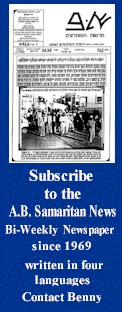
 CBS news Poll polled 899 adults
randomly in the United States. 14% said they were familiar with the
religious Samaritans, 83 % were not familiar with 3% don't know or did not
answer.
CBS news Poll polled 899 adults
randomly in the United States. 14% said they were familiar with the
religious Samaritans, 83 % were not familiar with 3% don't know or did not
answer. 



